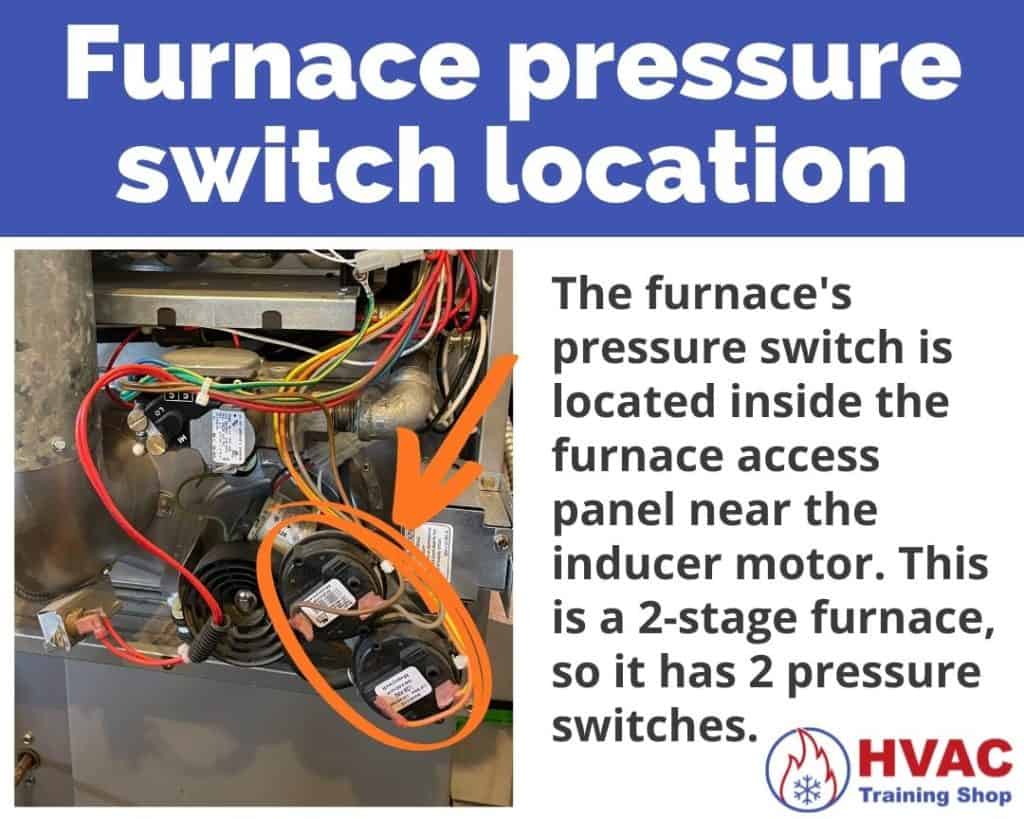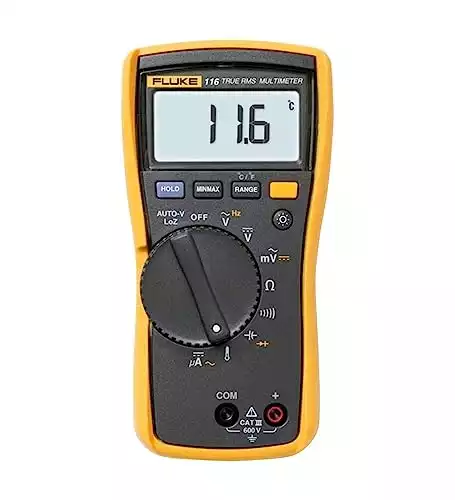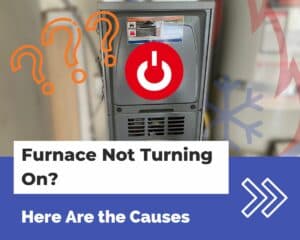If you find yourself in the unfortunate situation of a furnace pressure switch stuck open, don’t worry. In most cases, there are some simple things that can be done to fix the problem and get your furnace back up and running smoothly.
In this article, I’ll go over what to do when your furnace’s pressure switch is stuck open. I’ll also cover how to troubleshoot your furnace’s pressure switch, and how to replace your furnace’s pressure switch.
What to do when your furnace’s pressure switch is stuck open
First, it’s important to figure out why your furnace pressure switch is stuck open. Luckily there are some things that you can check before replacing the switch.
Check for debris or blockage in the flue vent
The #1 reason for a pressure switch to be stuck open is blockage in the furnace exhaust vent.
Blockage in the exhaust vent will prevent a furnace from heating, or shut it down completely.
Here are a few common sources of blockage in an exhaust vent:
- Branches or leaves
- Bird’s nest
- Soot buildup
- Snow
If you see any debris in the exhaust vent, then you’ll need to clean it out. Go where the exhaust vent opens up outside your home. Next, search for any signs of blockage in the vent.
If you find a blockage, then you need to remove it. Then your pressure switch should start working correctly again.
Make sure the inducer fan is starting
The inducer fan is responsible for venting the exhaust gases outside your home. If the inducer motor in your furnace is not starting, then the pressure switch won’t close. In fact, the entire purpose of the pressure switch is to ensure that the inducer fan is working properly.
Most times, you’ll be able to hear or see the inducer fan turn on. So that’s one way to know if it’s working properly.
For more advanced troubleshooting on furnace inducers, check out my article below:
Check the pressure switch hose
The pressure switch hose connects the pressure switch to the exhaust vent in your furnace. The hose is needed so the pressure switch can detect the pressure in the exhaust vent.
If the hose is damaged, cracked, or disconnected, then the pressure switch will stay open and your furnace won’t heat up.
If the hose is cracked or damaged, then it needs to be replaced.
If the hose is disconnected, then you will need to reconnect it.
If you have a two-stage furnace then you will have two pressure switches that you need to check.
Also, you need to check for moisture build-up inside the hoses if you have a high-efficiency furnace. Empty out any water from the hoses to ensure that the pressure switches can function properly.
How to troubleshoot your furnace’s pressure switch
If you checked everything above but the pressure switch is still not working, there are two different tests that you can do.
Both of these tests require a multimeter, so be sure you have one before proceeding.
The Fluke 116 is one of the best multimeters for diagnosing and troubleshooting issues in a residential furnace.
How to test for continuity across pressure switch terminals
The first thing that you should do when troubleshooting a pressure switch is to test for continuity across its terminals.
To test for continuity across the pressure switch, follow these steps:
- Turn off power to your furnace and open its access panel.
- Disconnect the two wires from the pressure switch.
- Touch the two terminals on the pressure switch with your multimeter leads. Use your multimeter on the resistance (Ω) or continuity setting to check if the pressure switch is closed. If the furnace is off, then the pressure switch terminals should be open, so you should see open line (OL) on your multimeter.
- Turn on power your furnace and set your thermostat to “HEAT” mode. The furnace’s inducer motor should start up.
- While the inducer fan is running, test the pressure switch in the same way that you did previously. However, this time, you should read a short circuit on your multimeter (or a low amount of resistance such as 0 or 1 Ω). If your multimeter is in continuity mode, it will beep.
- If your pressure switch passes all the tests above, then there is nothing wrong with your pressure switch! Go ahead and reconnect the wires to the pressure switch terminals and close up your furnace.
How to test for voltage across pressure switch terminals
Another method to test a furnace pressure switch is by measuring the voltage across its terminals.
To test for voltage across the pressure switch, follow these steps:
- Turn on your furnace and set your thermostat to “OFF” mode.
- Open your furnace’s access panel.
- Turn your multimeter on to the AC voltage setting (V~).
- Touch the two multimeter probes to the two terminals on the pressure switch. You should read somewhere between 24-28 volts. This means that the pressure switch is open.
- Set your thermostat to “HEAT” mode.
- Touch the two multimeter probes to the two terminals on the pressure switch. You should read somewhere between 0 volts. This means that the pressure switch is closed.
- If your pressure switch passes all the tests above, then there is nothing wrong with your pressure switch! Go ahead and close up your furnace.
How to replace a furnace pressure switch
Replacing the pressure switch on a furnace is not very difficult. You just need a few basic tools and some time to do the replacement.
The hardest part of replacing a pressure switch is finding a replacement pressure switch. It can be difficult to track down the correct part, especially for older furnaces.
I recommend looking for the part number on the old pressure switch. It should be printed on the pressure switch itself, or on a sticker. Once you find the part number, search for it on the internet. Most times you’ll be able to find it and buy it online.
To replace a pressure switch in a furnace, follow these steps:
- Turn off power to your furnace and open its access panel.
- Disconnect the two wires from the pressure switch.
- Disconnect the hose from the pressure switch. Make a note of which port the hose connects to.
- Remove the old pressure switch from the furnace. Most times, you just need to undo a few screws to remove the pressure switch.
- Install the new pressure switch inside the furnace. The new pressure switch might come with a bracket that holds it in place. If that’s the case, then you need to use the new bracket if it’s different than the old one. If it’s the same type of bracket, feel free to re-use the old one.
- Reconnect the hose to the new pressure switch in the same port that you removed it from earlier. The hose will connect to the negative port (–) on the pressure switch.
- Reconnect the wires to the new pressure switch. It does not matter which wire goes where. However, if your pressure switch has 3 terminals, then the wires need to connect to the Common (COM) and Normally Open (NO) terminals.
- Close up the access panel to your furnace and turn its power back on. Go ahead and test the furnace in “HEAT” mode on your thermostat to make sure everything works correctly.






Thanks much for the tutorial very easy to follow
Hi Jim,
Glad you found my article helpful! Hope you have success with your pressure switch issues.
Cheers,
-Trey
Christmas Day, 2022, found my father-in-law and me trying to diagnose this pressure switch open fault. Your checklist led to finding moisture in a pressure switch line and ultimately finding a blocked condensation trap. I can’t imagine what a service call would have cost on Christmas Day. Thanks a lot for taking the time to post this. You saved my in-laws a significant amount of money.
-Max
Thanks this article was very informative. One question tho – for a standard efficiency unit with roof metal vent – is it common for the vent to deteriorate over years and drop debris from this to affect the pressure switch ? Seems I’ve had this problem. I’m buying a new furnace and want the same standard type but am kinda Being talked in a new high efficiency side wall vent to avoid the metal vent problem. Should I be able to get many years of a metal vent through the roof without any type of corrosion problem? I would hope so. Thank you
Hi Chris,
That’s an interesting problem. I’ve never seen that before but in theory it is possible for exhaust vent deterioration to cause a change in pressure to affect the pressure switch.
There are many factors that go into whether you should choose a high efficiency furnace versus standard efficiency, so it would be wise to look at all of the pros and cons rather than just the metal versus PVC venting.